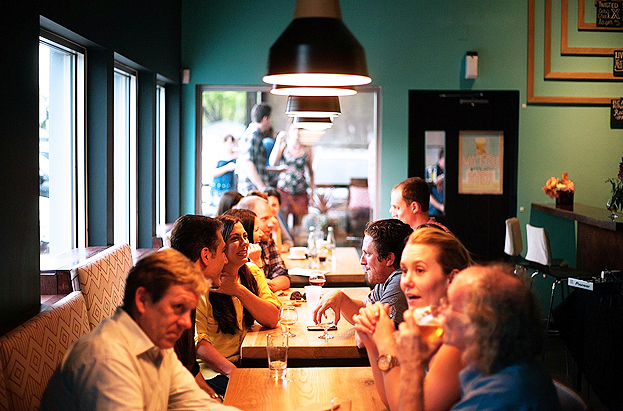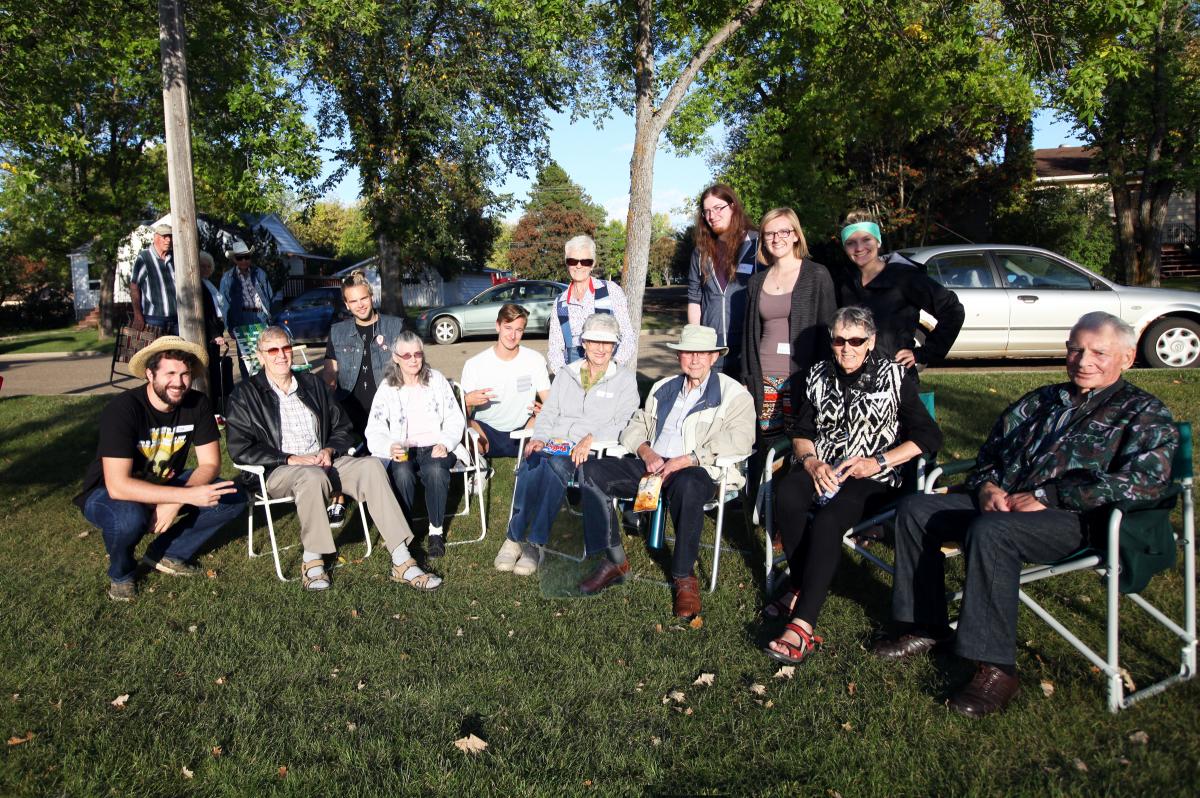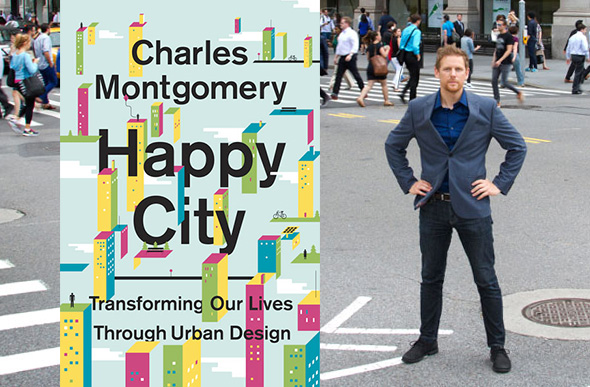
Canadians today feel lonelier than ever. But one university town is bucking the trend and building bridges that connect unlikely communities. What do they have to teach the rest of us?
There has been a wave of research in recent years on what makes people happy. Time and again, social scientists come up with the same answer: strong relationships that make us feel connected to one another.
Yet many Canadians are feeling lonelier than ever. In 2014, Maclean’s magazine reported over 30 per cent of Canadians feel disconnected from their neighbours. According to Statistics Canada, Canadians are seeing their friends less frequently. More of us are also living alone than ever before.
Even on university campuses, places designed to bring people together, students often feel disconnected and isolated. A 2012 report by the Canadian Association of College and University Student Services found that nearly two thirds of students reported feeling “very lonely” in the past 12 months.
And this has serious consequences. Persistent feelings of isolation can raise blood pressure, lower immunity, and boost levels of stress hormones that wear the body down. It impacts our health in a major way. But perhaps most pertinently, it also lowers the resilience of our communities in hard times. So the question of how to boost connectivity in our communities has real implications for the health of individuals, but also of our country.
Canada’s isolation crisis has been reported before. But the task of determining where to start when it comes to finding solutions is a different question altogether. And though the fate of Canada’s communities lies in many more hands than just those of university institutions, the story of one campus’s fight to build bridges between communities offers a glimpse of how these institutions, anchored in cities across the country, can be key pieces of Canada’s connection puzzle.
"Save our neighbourhood"
When I spent a week of my summer in Kingston, Ontario, living with friends in their shared student home, you could feel the tension between the permanent residents and their student neighbours. We spent most of our time socializing in the “student ghetto” surrounding Queen’s University. However, when I was outside those blocks I couldn’t help but feel unwanted and looked down upon by the permanent residents.
(SONAG) . . . believe[s] that, regretfully, discussion and dialogue over
many years have been unsuccessful in attaining a liveable neighbour-
hood. We cannot wait any longer, as our neighbourhood deteriorates."
My friend Aaron, who lived in the neighbourhood for three years during his undergrad, pointed out that there is even a website created by residents who wanted to “save the neighbourhood” from the “unacceptable behaviour of many Queen’s students.” That is, mostly, partying.
Kingston may be particularly notorious for police complaints and vandalism, but tension between homeowners and student renters can be a problem in near-campus neighbourhoods across the country.
The Camrose experience
In Camrose, a rural Albertan town of approximately 17,000 residents located about an hour’s drive southeast of Edmonton, about 500 students live off-campus, many of them in rental housing that surrounds the University of Alberta campus.
“Most near-campus neighbourhoods hate the university,” says Dittmar Mündel, president of the Augustana Neighbourhood Association. “It gets very seedy very quickly as soon as you approach the campus … [the housing is] more like ‘slum landlord’ rentals.”
Like other neighbourhoods near the campus, Augustana has had incidents of police complaints—particularly about noise—and complaints about the poor maintenance of student housing, which can lead to low property values.

members of the community during acommunity barbecue on September
10, 2015. Photo by Amielle Christopherson, the Camrose Canadian.
But about seven years ago, the Augustana Neighbourhood Association started taking a proactive approach by hosting community events for all residents.
Every September, for example, they co-host a big barbecue with the university to create a space where its members and students feel equally welcome. Mündel says the idea is to break down barriers between students and permanent residents, many of whom are seniors.
While we might roll our eyes at the idea that a measly community barbecue could hold the key to the community’s strife, studies show that the connections we build over burgers and discount soda pop should not be underestimated.
A 2014 report by the Caledon Institute of Social Policy found that community events and activities play a big role in creating the kinds of spaces where communities can form a common identity, social connections, and empathy among groups or group members. They “create vital social networks and foster a sense of belonging,” the report suggests. “We seriously undervalue the importance of community values,” it continues and recommends that governments “eliminate user fees for all community celebrations.”
Camrose Police Service patrol sergeant Craig Ferguson says the perception of Augustana as a problem neighbourhood has “gone down drastically,” and residents worry less about mischief and damage to vehicles. “I think it’s changed a lot,” he says. “[Now,] the students who are living in that area feel that they’re part of that area.”

president of the Augustana Neighbourhood Association.
“People appreciate that, and people appreciate
their neighbours.”
Mündel also says that now, noise complaints have mostly stopped. “It’s been a definite culture shift,” he says. “People appreciate that, and people appreciate their neighbours.”
Mündel says the Augustana Neighbourhood Association was inspired by a similar initiative by the University of Waterloo, Wilfrid Laurier University, and a near-campus neighbourhood in Waterloo, Ontario.
Shamir Mehta, manager of municipal enforcement services for the City of Waterloo, says community members are driving the process, which was started after the city found many of the complaints they received in the near-campus neighbourhood weren’t strictly bylaw issues, but a “lack of understanding.”
The city’s bylaw officers are “just a Band-Aid solution,” says Mehta. “It’s a change in culture where bylaw and police are putting the onus back on residents and students to be the solution.”
But there’s more to it than that. In 2012, the city of Waterloo released a report detailing the need for properly designed spaces and development, as well as an improved sense of community through public gatherings. Building on the recognition of the value the community gatherings offered, the report made clear the natural extension of that logic: if we want people to gather in order to build community, they need to live in places that encourage them to do so.
Happy neighbourhoods
How our neighbourhoods look and feel can also have a huge effect on health and happiness, says Omar Dominguez, director of operations and sustainability at Happy City, an organization that explores how the design of buildings, neighbourhoods, and cities affects wellbeing and happiness.
“The design of physical environments can nudge people into conviviality, generosity and altruism, or they can nudge us towards fear and separation,” says Dominguez.
Strong relationships, he says, are “the single most important factor of human happiness,” and strong relationships with neighbours matter just as much as they do with close friends and family.
These relationships have financial benefits as well. Economists have found that in areas where people place more trust in each other—where there is more “social capital”—economic growth is stronger.
Dominguez says creating environments with many street-front businesses and natural elements, like trees, “slows people down—people are nicer and kinder."
But many of our neighbourhoods aren’t built like this.

Montgomery examines the intersection between urban design and the
emerging science of happiness. Image from Vancouver Is Awesome.
As of 2011, more than 16 million Canadians live in automobile-dependent neighbourhoods, according to a 2014 report from the School of Urban and Regional Planning at Queen’s University. When cities are designed such that residential housing, workplaces, shopping, and entertainment are located in different areas, it’s difficult for people to interact. Despite evidence that these sprawling suburban neighbourhoods negatively affect health, developers continue to create these neighbourhoods and the market for large, suburban homes remains strong across North America.
*Housing preferences among millennials, however, tend towards smaller, higher-density housing close to activities, signs that changing economic realities and the generation shift will create more demand for housing in compact, walkable neighbourhoods.
"No longer just your neighbour"
And when it comes to near-campus neighbourhoods, they have even more specific challenges.
Researchers have found, for example, that as communities become more diverse, trust among community members decreases. In other words, it’s more difficult to achieve a sense of community in places where there are strong demographic and economic divisions, like those that exist between middle-aged homeowners and student renters. Economic competition in particular “makes people dislike each other even more and creates rigid group boundaries,” according to Sean Moore, a psychology professor at the University of Alberta who specializes in emotion.
This is precisely why the story of what the University of Alberta and the Augustana Neighbourhood Association achieved is so remarkable. As both Moore and Dominguez point out, you can’t force groups together and create a community just by putting them in physical contact with one another. People want to maintain their differences, but also feel like they belong, which is precisely what the community barbecues accomplished.
This feeling of belonging is the difference I felt between the neighbourhood where my friend lived in Kingston and the Augustana neighbourhood in Camrose, where I live now. Other students who live here feel it, too.
“Humans need relationships with each other. I think we’ve lost that simple truth,” said Tim Faltin, a fourth-year environmental science student at the University of Alberta. “It just kind of changes the way you look at your neighbours.
“[They're] no longer just your neighbour. There’s so much more added to that.” 
This article was reprinted in its entirety from discoursemedia.org. Read the original article here.

